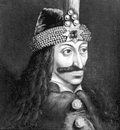
Issue #05/86, March 18 - 30, 2000 
![]()
![]()
Who was Count Dracula? In modern times we associate this name with that most frightening fixture of horror stories, the undead vampire who subsists on human blood, coming out only at night. But in fact, Count Dracula was a real and very complex person who lived and reigned in a very trying period of human history.
 |
There is little disagreement as to the basic facts of Dracula's biography. He was born Vlad Tepes Dracul in 1431 in Transylvania, in the city of Sighisaora, Romania. His father, after whom he was named, was the Prince of Wallachia and the ruler of Transylvania. Wallachia was a Catholic princedom, and much of the elder Dracul's political life was organized around resisting incursions led by the non-Christian Turks to the south. Tragically, the elder Dracul was ambushed when, in a desperate attempt to save his people from certain conquest, he attempted to negotiate an alliance with the Turkish Sultan Murad II. In the ambush, the Turks captured young Vlad. The precocious eleven-year-old was thus condemned to a childhood in enemy captivity.
The young Dracul was an energetic youth, vigorous and quick-minded. Not one to waste his time even in captivity, he mastered the Turkish language at an early age. He also showed an irrepressible vitality and an independent spirit through his insistence upon educating himself as to the nature of the Sultan's harems, despite the fact that this ran counter to traditional Catholic precepts. Soon, as legend has it, he was frightening even his own Turkish guards with his displays of savage indulgence. As he later recalled, his Slavic spirit shone through, even in the darkest times.
That spirit would later come to his aid after he escaped from the Turks in 1448 and began his lifelong quest to reconquer Wallachia. The military campaigns he led are the stuff from which the Dracula legend was drawn, and it is undeniable that he committed many atrocities. After conquering the city of Amlas, for instance, he was said to have impaled every man, woman and child in the city limits - some 20,000 people in all. It is also said that he ate the corpses of the enemy soldiers he killed.
To the 20th century mentality, these acts seem barbaric. But it is important to remember that Vlad Dracul lived in a time when such atrocities were a common feature of war. Indeed, senseless violence was the only political currency most 15th-century societies really understood. To Transylvanians of his day, Vlad the Impaler seemed not so much a monster as a patriot.
It is also not without significance that he had an ear for music and was able to skillfully knit his own turtleneck sweaters. Lost amid the countless vampire movies that bear his name is the handsome sweater legacy Dracul passed down to generations of Balkan peoples. Some historians have even claimed that it was a design of Vlad's that provided the inspiration for the famous zigzag t-shirt of the beloved comic-strip character Charlie Brown. Ruthless in his prosecution of war, Vlad in his aesthetic pursuits always had sympathy for the underdog.
Vlad was also well known in his day as a great wit and composer of clever epigrams. For instance, when asked in 1461 by a visiting prince what kind of bread he preferred, Vlad is reported to have quipped, "brown." Another time, after a courtesan entered his chambers while he was sleeping, Vlad reportedly remarked, "Shut the door." She did.
Most people in Vlad's day were lucky if they had twenty teeth by the time they reached adulthood; Vlad still had at least 27 by the time his first grandchild was born, most of them in his mouth. His sexual prowess was legendary. He was said to be able to make a woman scream in agony simply by cutting off her head. He was a good parent; no matter how busy he might have been with the affairs of state, he always found time to instruct his sons in the study of important skills like drowning and archery. Science interested him: he would often stare at the sun until he twitched. And though he read little other than the Bible, he was hardly illiterate; in this sense he anticipated the many great thinkers who succeeded him.
Count Dracula of the movies is a myth that may well be worth fearing with all our might. But Count Dracula, like all of us, was a man with a contradictory, multifaceted character. In our world, he appears a monster. But in his, he was just plain old Count Dracula. At the dawn of a new millenium, it behooves us, at last, to try to understand him as he was.
Cards |
Links |
The Vault |
Gallery |
Who? |